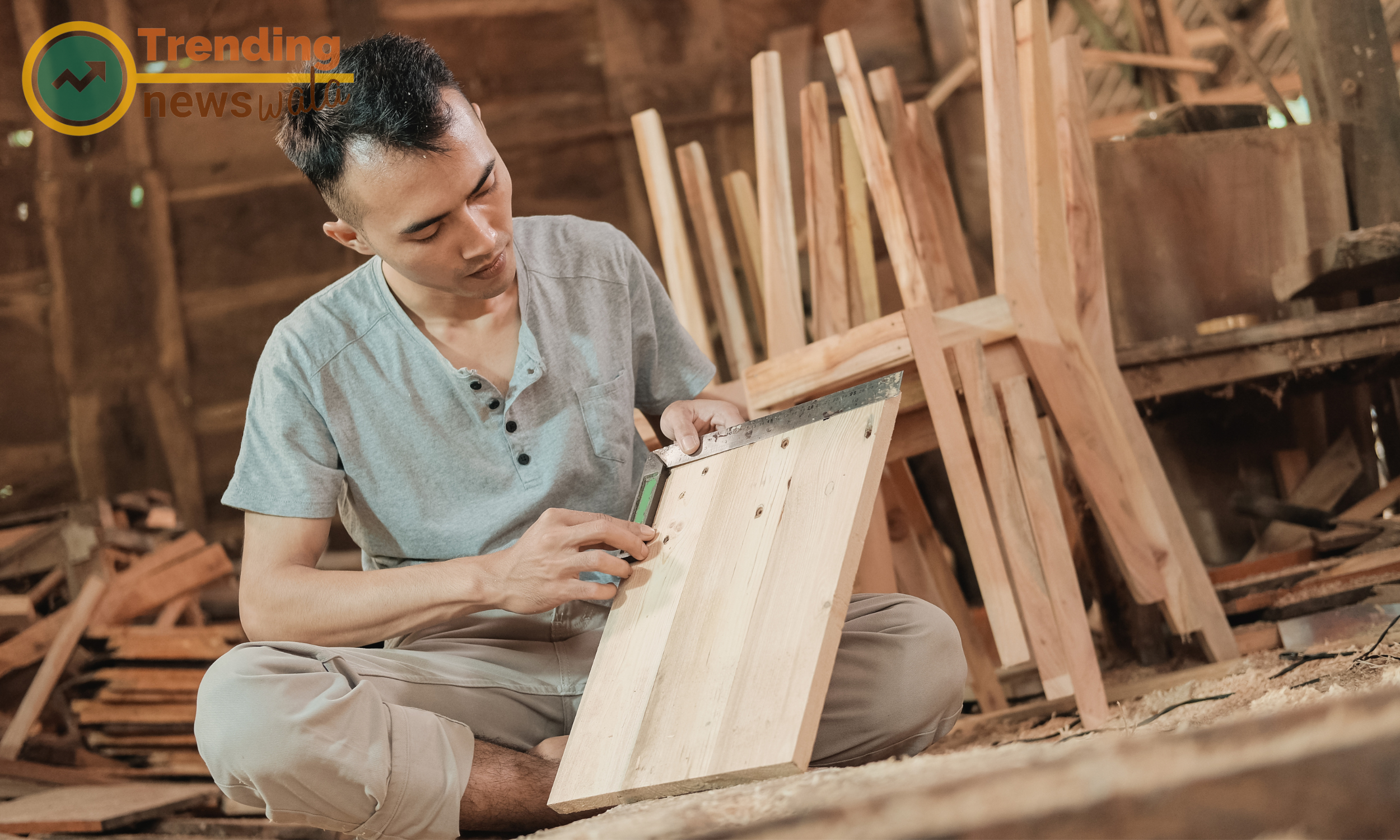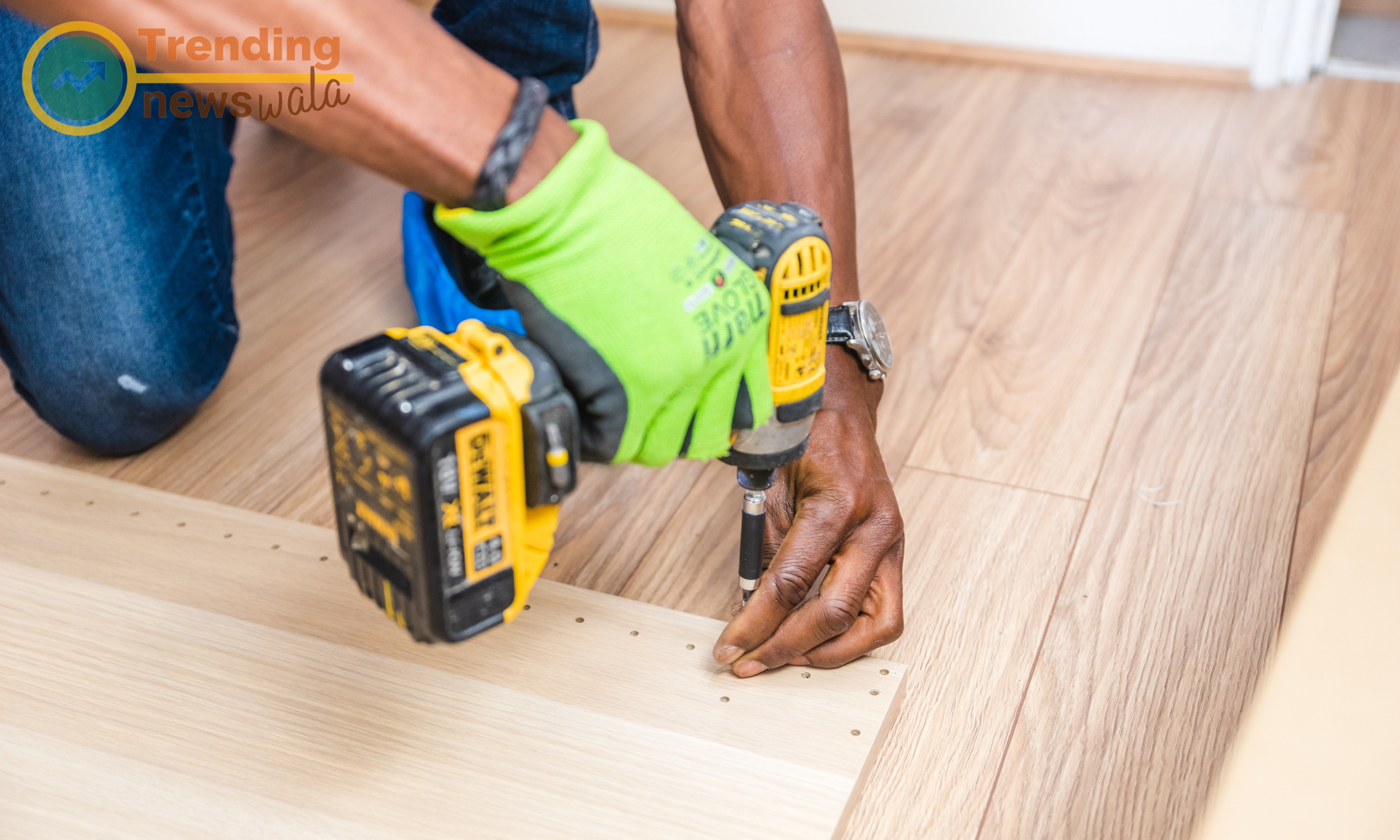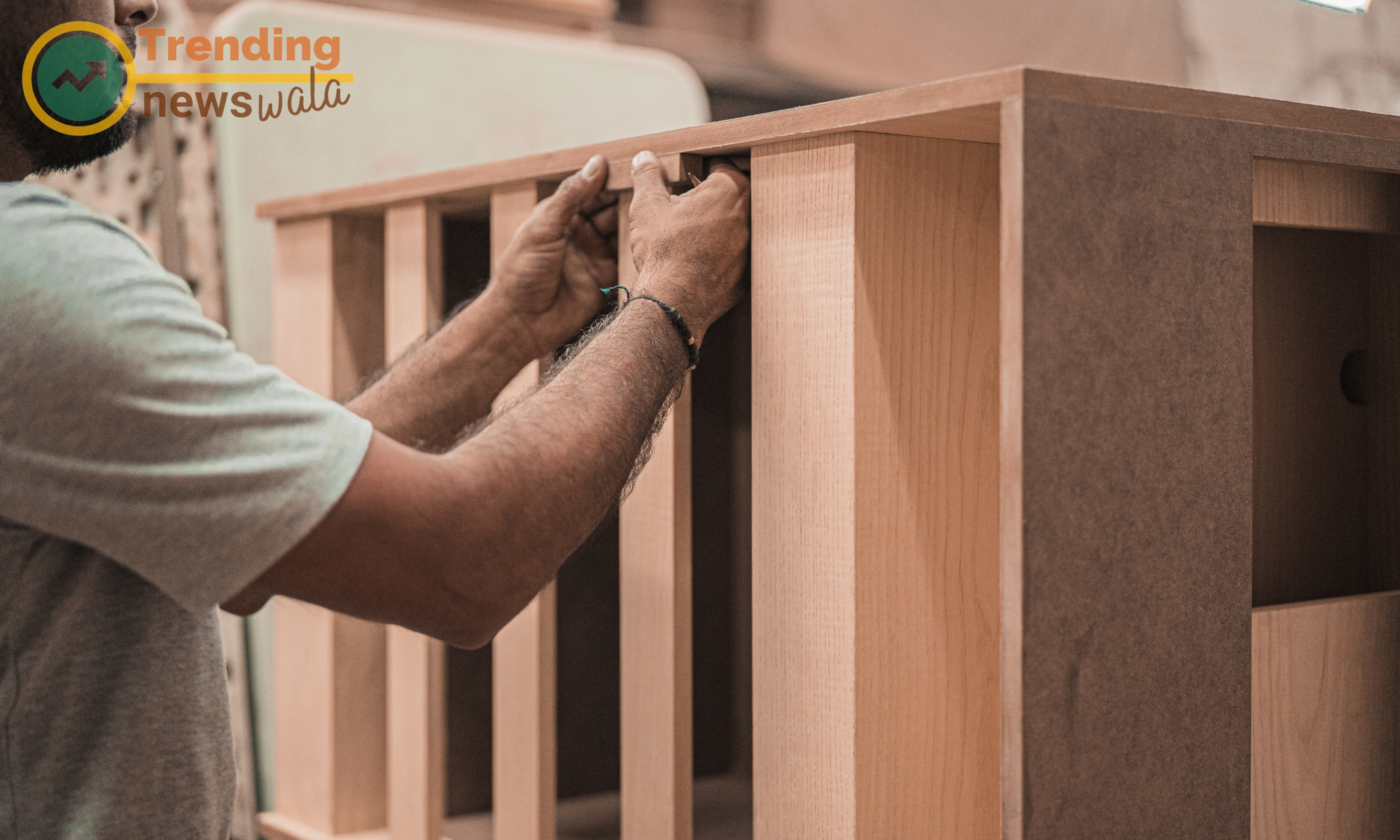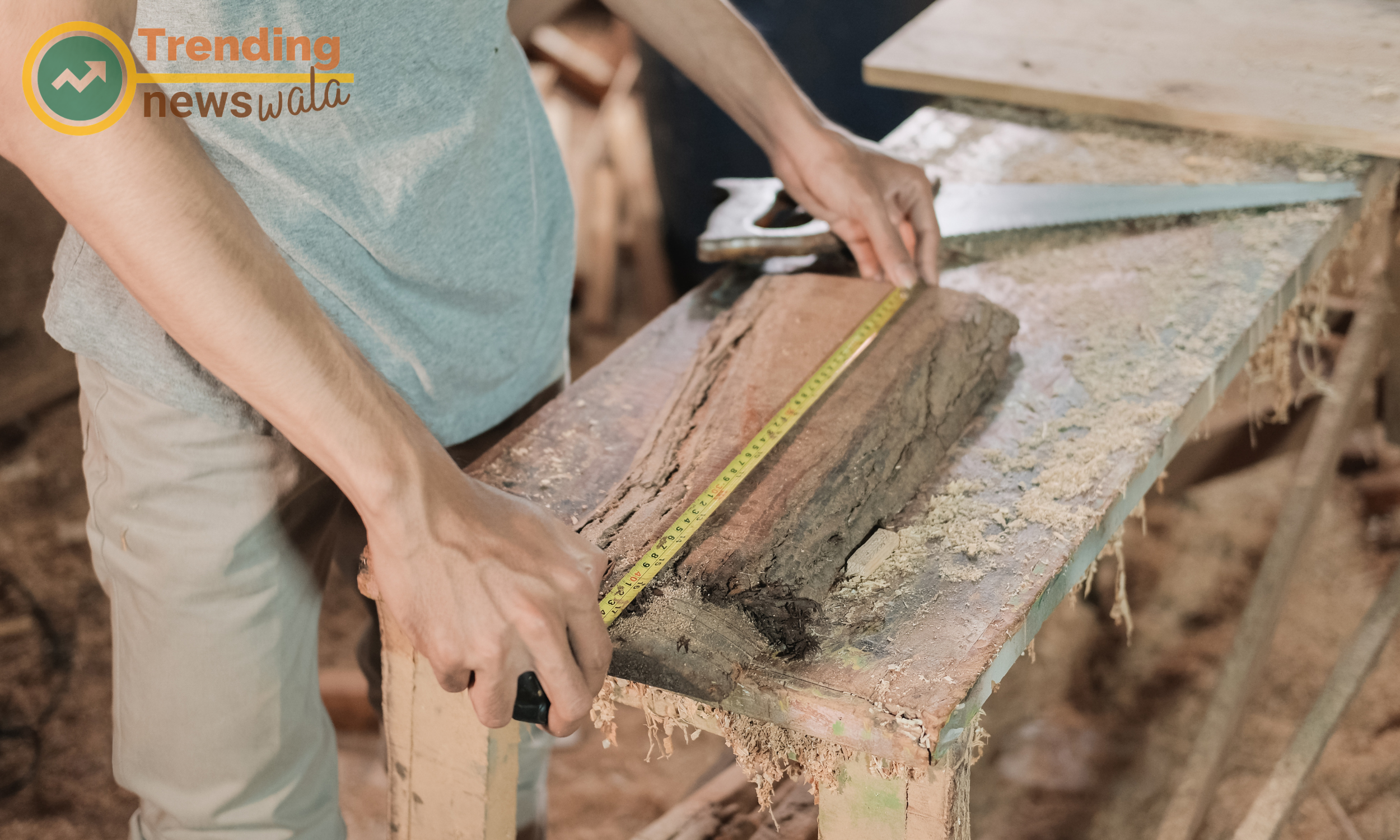What does a Carpenter do
The versatile world of carpentry from crafting wooden masterpieces to framing structures do their skills and construction and woodworking
The versatile world of carpentry from crafting wooden masterpieces to framing structures do their skills and construction and woodworking

Carpentry, a time-honored craft, involves much more than simply working with wood. Carpenters are skilled artisans who contribute to the creation and construction of structures, furniture, and various wooden elements. In this article, we delve into The diverse and essential roles of carpenters, exploring the depth of their craft and the impact they have on the world around us.
In essence, a carpenter is a master of transformation, turning raw materials into functional structures and beautiful pieces of craftsmanship. Whether framing the skeleton of a building, adding the finishing touches to a home, or crafting bespoke furniture, carpenters play a pivotal role in shaping the physical world we inhabit. Their dedication to precision, creativity, and craftsmanship ensures that the art of carpentry continues to thrive and evolve in the contemporary landscape.

Here are more details on how carpentry is defined:
At its core, carpentry is the art and trade of working with wood, encompassing a wide range of skills and techniques. Carpenters utilize their expertise to shape, join, and assemble wooden components, transforming raw materials into functional and aesthetic structures.
Carpentry is a versatile and skilled trade that involves working with wood to create, construct, and install various structures and components. Here are more details on how carpentry is defined:
Material Expertise: Carpenters primarily work with wood, but their expertise extends to various types of wood, including softwoods and hardwoods. They understand the characteristics, strengths, and limitations of different wood species, allowing them to select the most suitable materials for specific projects.
Tool Proficiency: Carpenters are proficient in the use of a wide array of hand tools and power tools. From basic hand saws and chisels to advanced power saws and routers, carpenters rely on their tool skills to cut, shape, join, and finish wood with precision.
Construction Knowledge: In the construction industry, carpenters are integral to the building process. They interpret architectural blueprints and plans, understanding the structural requirements and specifications. Construction carpentry involves tasks such as framing walls, installing roofing structures, and creating foundational elements.
Joinery Techniques: Joinery is a fundamental aspect of carpentry, involving the art of connecting and securing wooden pieces. Carpenters use various joinery techniques, including mortise and tenon joints, dovetail joints, and lap joints, to create strong and durable connections.
Measurement and Accuracy: Precision is paramount in carpentry. Carpenters meticulously measure and mark wood, ensuring that each cut and joint is accurate. This attention to detail is crucial for the structural integrity and aesthetic appeal of the final product.
Rough Carpentry: Rough carpentry involves the initial stages of construction, focusing on the framework and structural elements of a building. Carpenters in this specialization handle tasks such as framing walls, floors, and roofs, as well as installing wooden components that provide the basic structure for the entire building.
Finish Carpentry: Finish carpentry comes into play during the final stages of construction. Carpenters in this role add the finishing touches that enhance the aesthetics of a structure. This includes installing trim, moldings, baseboards, cabinetry, and other decorative elements that contribute to the overall appearance of a space.
Furniture Making: Carpenters skilled in furniture making create custom and unique pieces of furniture. This involves designing, crafting, and assembling wooden furniture items, ranging from simple tables and chairs to intricate and bespoke pieces.
Restoration Carpentry: Restoration carpentry focuses on preserving historical structures and antique furniture. Carpenters in this field use traditional techniques to repair, restore, or recreate wooden elements while maintaining the authenticity and historical value of the original piece.
Adaptability and Creativity: Carpenters need to be adaptable and creative problem-solvers. They often encounter unique challenges in their projects and must find innovative solutions to ensure the successful completion of the task at hand.
In summary, carpentry is a multifaceted trade that combines technical skills, craftsmanship, and creativity to work with wood in various capacities. Whether contributing to construction projects, crafting furniture, or restoring historical pieces, carpenters play a vital role in shaping the built environment.

One primary role of carpenters is in the construction industry
One primary role of carpenters is in the construction industry. Construction carpenters are integral to building projects, working on everything from residential homes to commercial structures. They interpret blueprints, take measurements, and use a variety of tools to cut, shape, and install wooden frameworks, beams, and support structures.
Construction carpentry is a specialized branch of carpentry that focuses on the construction and framing of buildings. Carpenters in this field are involved in the initial stages of a construction project, working to create the essential structural framework that forms the skeleton of a building. Here are more details about construction carpentry:
Blueprint Interpretation: Construction carpenters begin their work by interpreting architectural blueprints and construction plans. They analyze the designs to understand the layout, dimensions, and structural requirements of the building.
Site Preparation: Before construction begins, carpenters in this field may be involved in site preparation tasks. This can include clearing the construction area, leveling the ground, and creating a foundation for the building.
Framing: Framing is a key aspect of construction carpentry. Carpenters construct the frame of the building, which includes the walls, floors, and roof structure. This framing provides the structural support for the entire building.
Wall Framing: Carpenters build the walls by framing them with wooden studs, plates, and headers. The framing needs to be precise to ensure the walls are straight, level, and capable of supporting the loads they will bear.
Floor Framing: Floor framing involves creating the structure that supports the flooring materials. Carpenters install joists, beams, and subflooring to create a sturdy and level foundation for the building's floors.
Roof Framing: Carpenters are responsible for constructing the roof framework, which includes rafters, trusses, and other components. The roof framing provides the structure for the roof covering and ensures the building is protected from the elements.
Installation of Structural Components: Construction carpenters install various structural components, including columns, beams, and load-bearing elements. These components are strategically placed to distribute the weight of the building and ensure its stability.
Door and Window Openings: Carpenters create openings for doors and windows in the walls during the framing process. Precise measurements and proper framing are crucial to ensure that doors and windows fit correctly and align with the architectural design.
Collaboration with Other Trades: Construction carpenters work closely with professionals from other trades, such as electricians, plumbers, and HVAC technicians. They coordinate the placement of structural elements to accommodate utilities and ensure the integration of different building systems.
Code Compliance: Construction carpenters must adhere to local building codes and regulations. Compliance ensures that the construction meets safety standards and legal requirements.
Quality Control: Quality control is a vital aspect of construction carpentry. Carpenters inspect their work regularly to ensure that all components are properly aligned, securely fastened, and meet the specifications outlined in the construction plans.
Adaptability: Construction carpenters need to be adaptable and able to work in various environments and conditions. They may face challenges such as uneven terrain, inclement weather, or tight deadlines and must adjust their approach accordingly.
In essence, construction carpentry lays the foundation for the entire construction process. The precision and skill of carpenters in this field are critical to the structural integrity, safety, and success of a building project. Their work sets the stage for the subsequent phases of construction and contributes significantly to the durability and longevity of the built structure.

Rough carpenters focus on the initial stages of construction
Rough carpenters focus on the initial stages of construction, dealing with the framing and structural elements of a building. They handle tasks such as creating formwork for concrete, installing floor joists, and erecting the framework that provides the skeleton for the entire structure.
Rough carpentry is a specialized branch of carpentry that involves the early and foundational stages of construction. Carpenters specializing in rough carpentry are primarily responsible for creating the structural framework of a building. Here are more details about rough carpentry:
Foundation Work: Rough carpentry often starts with foundation work. Carpenters in this stage may be involved in setting forms for concrete footings and foundations. They ensure that the foundation is level, properly aligned, and capable of supporting the weight of the entire structure.
Framing Walls: Wall framing is a key aspect of rough carpentry. Carpenters construct the frame of the building by installing wooden studs, plates, and headers. The framing provides the essential structure for walls, defining the layout of rooms and supporting the weight of the upper floors and roof.
Floor Framing: Rough carpenters are responsible for the floor framing, which involves creating the framework that supports the building's floors. This includes installing joists, beams, and subflooring to establish a sturdy and level foundation.
Roof Structure: Carpenters in rough carpentry work on the roof structure, which includes constructing rafters, trusses, and other components. The roof framing provides the necessary support for the roof covering and ensures the building is protected from the elements.
Installation of Load-Bearing Elements: Load-bearing elements such as columns and beams are installed by rough carpenters. These elements distribute the weight of the building and contribute to its overall stability.
Creation of Openings: Rough carpenters create openings for doors, windows, and other architectural features during the framing process. The placement of these openings is crucial for the overall design and functionality of the building.
Installation of Sheathing: Sheathing is applied to the exterior of the frame to provide additional strength, rigidity, and a surface for attaching exterior finishes. This layer acts as a protective barrier against the elements.
Collaboration with Other Trades: Rough carpenters collaborate with professionals from other trades, such as plumbers and electricians. They create spaces and pathways within the framing to accommodate utility lines and systems.
Structural Integrity: Ensuring the structural integrity of the building is a primary focus of rough carpentry. Carpenters must follow engineering specifications and adhere to building codes to guarantee that the frame can withstand the intended loads and stresses.
Quality Control: Rough carpenters conduct regular inspections of their work to ensure that all framing components are securely fastened, properly aligned, and meet the standards set by the construction plans.
Adaptability: Rough carpenters need to be adaptable and able to work in various conditions. They may encounter challenges such as uneven terrain or the need to accommodate unique architectural features, requiring flexibility in their approach.
In summary, rough carpentry lays the essential groundwork for a building's construction. The precision and skill of carpenters in this field are crucial to creating a strong and stable structure that forms the backbone of the entire building. The work of rough carpenters sets the stage for subsequent phases in construction, shaping the overall design and functionality of the built environment.

Finish carpenters, on the other hand
Finish carpenters, on the other hand, specialize in the final touches that enhance the aesthetics and functionality of a structure. Their work involves installing moldings, trim, cabinetry, and other decorative elements that add character and refinement to a space.
Rough carpentry is a specialized branch of carpentry that involves the early and foundational stages of construction. Carpenters specializing in rough carpentry are primarily responsible for creating the structural framework of a building. Here are more details about rough carpentry:
Foundation Work: Rough carpentry often starts with foundation work. Carpenters in this stage may be involved in setting forms for concrete footings and foundations. They ensure that the foundation is level, properly aligned, and capable of supporting the weight of the entire structure.
Framing Walls: Wall framing is a key aspect of rough carpentry. Carpenters construct the frame of the building by installing wooden studs, plates, and headers. The framing provides the essential structure for walls, defining the layout of rooms and supporting the weight of the upper floors and roof.
Floor Framing: Rough carpenters are responsible for the floor framing, which involves creating the framework that supports the building's floors. This includes installing joists, beams, and subflooring to establish a sturdy and level foundation.
Roof Structure: Carpenters in rough carpentry work on the roof structure, which includes constructing rafters, trusses, and other components. The roof framing provides the necessary support for the roof covering and ensures the building is protected from the elements.
Installation of Load-Bearing Elements: Load-bearing elements such as columns and beams are installed by rough carpenters. These elements distribute the weight of the building and contribute to its overall stability.
Creation of Openings: Rough carpenters create openings for doors, windows, and other architectural features during the framing process. The placement of these openings is crucial for the overall design and functionality of the building.
Installation of Sheathing: Sheathing is applied to the exterior of the frame to provide additional strength, rigidity, and a surface for attaching exterior finishes. This layer acts as a protective barrier against the elements.
Collaboration with Other Trades: Rough carpenters collaborate with professionals from other trades, such as plumbers and electricians. They create spaces and pathways within the framing to accommodate utility lines and systems.
Structural Integrity: Ensuring the structural integrity of the building is a primary focus of rough carpentry. Carpenters must follow engineering specifications and adhere to building codes to guarantee that the frame can withstand the intended loads and stresses.
Quality Control: Rough carpenters conduct regular inspections of their work to ensure that all framing components are securely fastened, properly aligned, and meet the standards set by the construction plans.
Adaptability: Rough carpenters need to be adaptable and able to work in various conditions. They may encounter challenges such as uneven terrain or the need to accommodate unique architectural features, requiring flexibility in their approach.
In summary, rough carpentry lays the essential groundwork for a building's construction. The precision and skill of carpenters in this field are crucial to creating a strong and stable structure that forms the backbone of the entire building. The work of rough carpenters sets the stage for subsequent phases in construction, shaping the overall design and functionality of the built environment.

Carpenters skilled in furniture making
Carpenters skilled in furniture making create bespoke pieces that range from classic to contemporary designs. They work with a variety of wood types, combining artistry with functionality to craft tables, chairs, cabinets, and other custom furniture items.
Furniture making is a specialized aspect of carpentry that involves designing, crafting, and assembling wooden furniture pieces. Furniture makers, often referred to as cabinetmakers or woodworkers, create a wide range of furniture items, from functional and practical pieces to artistic and decorative works. Here are more details about furniture making:
Design and Planning: Furniture making begins with design and planning. Furniture makers may work from existing designs or create custom pieces based on client preferences. The design phase involves considering aesthetics, functionality, and the overall style of the furniture.
Selection of Wood: Choosing the right type of wood is a critical aspect of furniture making. Furniture makers consider the wood's grain, color, durability, and workability. Common wood types used in furniture making include oak, maple, walnut, cherry, and mahogany.
Measuring and Cutting: Precision is key in furniture making. Furniture makers carefully measure and mark the wood before making precise cuts. Advanced tools such as table saws, band saws, and routers are often used to achieve accurate and clean cuts.
Joinery Techniques: Joinery involves connecting and securing wooden pieces to create a sturdy and durable structure. Furniture makers use a variety of joinery techniques, including dovetails, mortise and tenon joints, dado joints, and biscuit joints, depending on the design and purpose of the furniture.
Shaping and Carving: Furniture makers may shape and carve wood to create intricate details or decorative elements. This can include carving patterns, adding bevels or chamfers, and creating curves or contours to enhance the visual appeal of the furniture.
Assembling Components: Once individual components are prepared, furniture makers assemble them according to the design. This may involve using glue, screws, dowels, or other fastening methods to create a cohesive and stable piece of furniture.
Finishing: Finishing is a crucial step that enhances the appearance and protects the wood. Furniture makers apply finishes such as stains, varnishes, lacquers, or oils to achieve the desired color and texture. Finishing also provides protection against wear, moisture, and other environmental factors.
Customization: Furniture making often involves customization to meet the unique needs and preferences of clients. This can include creating furniture with specific dimensions, incorporating storage solutions, or adapting designs to match existing decor.
Replication and Restoration: Furniture makers may replicate existing pieces or restore antique furniture. Replication requires precision in recreating the original design, while restoration involves repairing, refinishing, and preserving the historical integrity of older furniture.
Collaboration with Clients: Effective communication with clients is vital in furniture making. Furniture makers collaborate with clients to understand their vision, preferences, and functional requirements, ensuring the final piece meets or exceeds expectations.
Use of Technology: Modern furniture makers may incorporate technology such as computer-aided design (CAD) software, CNC (computer numerical control) machines, and 3D printing to enhance precision and efficiency in the design and production process.
Sustainability Practices: Some furniture makers prioritize sustainable practices, choosing responsibly sourced wood and eco-friendly finishes. This aligns with growing consumer awareness and demand for environmentally conscious furniture.
In summary, furniture making is a skilled craft that blends creativity, technical expertise, and precision. Furniture makers contribute to the creation of functional, aesthetically pleasing, and often custom pieces that enhance living spaces and reflect individual tastes and styles.

Restoration carpentry is a specialized field within carpentry
Preserving historical structures and restoring antique furniture requires the expertise of restoration carpenters. These craftsmen employ traditional techniques to repair, replicate, or recreate wooden elements while maintaining the authenticity and integrity of the original piece.
Restoration carpentry is a specialized field within carpentry that focuses on preserving, repairing, and restoring historical structures, architectural elements, and antique wooden objects. Carpenters involved in restoration work use traditional techniques and materials to maintain the authenticity and historical integrity of the items they work on. Here are more details about restoration carpentry:
Historical Preservation: The primary goal of restoration carpentry is the preservation of historical structures and artifacts. Carpenters in this field aim to protect and maintain the original features, materials, and craftsmanship of a building or piece of furniture.
Understanding Historical Architecture: Restoration carpenters have a deep understanding of historical architecture and construction methods. They study the architectural styles, techniques, and materials prevalent during the period in which the structure or object was built.
Documentation and Research: Prior to restoration work, carpenters conduct extensive research and document existing conditions. This may involve studying old photographs, architectural drawings, and historical records to gain insights into the original design and construction.
Assessment of Structural Integrity: Restoration carpenters assess the structural integrity of historical buildings or objects. They identify areas of deterioration, damage, or structural instability and develop a comprehensive plan for repair and restoration.
Traditional Joinery Techniques: Traditional joinery techniques play a significant role in restoration carpentry. Carpenters use methods such as mortise and tenon joints, dovetail joints, and other historically accurate techniques to ensure that repairs seamlessly integrate with the original craftsmanship.
Wood Species Matching: Restoration carpenters carefully select wood species that match the original materials used in historical structures. This ensures a harmonious blend between the new and existing elements.
Repairing and Replicating Components: Carpentry work in restoration involves repairing damaged components and replicating missing or irreparable elements. This can include repairing wooden beams, columns, doors, windows, moldings, and other architectural features.
Surface Finishes and Patina Matching: Achieving an authentic appearance is essential in restoration carpentry. Carpenters pay attention to replicating surface finishes, colors, and patinas to match the original appearance of the woodwork.
Conservation Ethics: Restoration carpenters adhere to conservation ethics, emphasizing minimal intervention to preserve as much of the original material as possible. They avoid unnecessary alterations that could compromise the historical value of the structure or object.
Cleaning and Stripping Techniques: When necessary, restoration carpenters employ careful cleaning and stripping techniques to remove layers of paint or finishes without causing damage to the underlying wood. This requires a delicate balance to preserve original details.
Weathering and Aging Replication: Carpenters may use techniques to replicate the natural weathering and aging of wood, ensuring that restored components blend seamlessly with the surrounding historical elements.
Environmental Considerations: Restoration carpenters consider environmental factors, such as humidity and temperature, which can impact the longevity and stability of restored wooden structures. They may recommend environmental controls to protect the restored elements.
Collaboration with Preservationists: Restoration carpenters often collaborate with preservationists, architects, historians, and other professionals involved in the broader field of historic preservation. This collaborative approach ensures a comprehensive and well-informed restoration process.
In summary, restoration carpentry is a meticulous and specialized craft that requires a deep appreciation for history, craftsmanship, and traditional building techniques. Carpenters in this field play a crucial role in safeguarding cultural heritage by preserving the physical remnants of the past for future generations.

Carpenters often engage in custom woodworking projects
Carpenters often engage in custom woodworking projects, catering to the unique needs and preferences of clients. From crafting intricate wooden staircases to building specialized storage solutions, custom carpentry showcases the versatility and creativity of the trade.
Custom woodworking is a specialized branch of carpentry that involves creating unique, tailor-made wooden pieces to meet specific design preferences and functional requirements. Woodworkers or carpenters in this field focus on producing one-of-a-kind items that showcase craftsmanship, creativity, and attention to detail. Here are more details about custom woodworking:
Client Collaboration: A fundamental aspect of custom woodworking is collaborating closely with clients. Woodworkers discuss the client's vision, preferences, and specific needs to understand the desired aesthetic and functionality of the custom piece.
Design and Planning: Custom woodworking begins with the design and planning phase. Woodworkers use their expertise to translate the client's ideas into detailed plans, considering dimensions, materials, joinery techniques, and any unique features requested.
Material Selection: Choosing the right wood is crucial in custom woodworking. Woodworkers consider the type, grain pattern, color, and durability of different wood species. Exotic hardwoods, reclaimed wood, or specialty materials may be selected based on the client's preferences.
Precision Measurements: Precision is paramount in custom woodworking. Woodworkers take accurate measurements to ensure that the final piece fits seamlessly into the intended space and meets the client's specifications.
Handcrafting Techniques: Custom woodworking often involves handcrafting techniques to create unique details and features. Woodworkers may use hand tools such as chisels, hand saws, and carving tools to add intricate designs or embellishments.
Joinery Expertise: Joinery techniques play a crucial role in custom woodworking. Woodworkers use traditional joinery methods like mortise and tenon joints, dovetails, and finger joints to create strong and aesthetically pleasing connections between wooden components.
Cabinetmaking: Custom woodworking frequently extends to cabinetmaking. Woodworkers design and craft custom cabinets for kitchens, bathrooms, living spaces, or commercial settings. This involves creating storage solutions that are both functional and visually appealing.
Unique Furniture Pieces: Woodworkers in this field often create unique furniture pieces tailored to individual preferences. This can include custom tables, chairs, bed frames, entertainment units, and other furniture items that reflect the client's style.
Functional Art: Custom woodworking sometimes crosses into the realm of functional art. Woodworkers may create pieces that serve both practical and artistic purposes, blurring the lines between traditional furniture and artistic expression.
Inlay and Marquetry: Inlay and marquetry techniques are used to add decorative elements to custom woodworking projects. This involves embedding contrasting wood, veneers, or other materials into the surface of the wood to create intricate patterns or designs.
Wood Finishing: Achieving the desired finish is a critical step in custom woodworking. Woodworkers apply stains, varnishes, oils, or other finishes to enhance the natural beauty of the wood and protect it from wear and environmental factors.
Eco-Friendly Practices: Some custom woodworkers prioritize eco-friendly practices by using sustainably sourced wood, reclaimed materials, and environmentally friendly finishes. This aligns with the growing demand for sustainable and responsible craftsmanship.
Continuous Communication: Throughout the woodworking process, ongoing communication with the client is essential. Woodworkers provide updates on progress, seek feedback, and make adjustments based on the client's preferences to ensure complete satisfaction.
Unique Challenges: Custom woodworking often presents unique challenges, as each project is distinct. Woodworkers must problem-solve and adapt their skills to meet the specific requirements and complexities of each custom piece.
In summary, custom woodworking is a highly personalized and artistic form of carpentry. Woodworkers in this field bring creativity, technical expertise, and a commitment to craftsmanship to create bespoke pieces that resonate with the individual tastes and needs of their clients.

Carpenters frequently collaborate with professionals from other trades
Carpenters frequently collaborate with professionals from other trades, including architects, electricians, and plumbers. Their input is crucial in ensuring that the structural and design elements align seamlessly, contributing to the overall success of a construction project.
Collaborating with other trades is a crucial aspect of various carpentry specializations, including construction carpentry, restoration carpentry, and custom woodworking. Effective collaboration ensures that different aspects of a project come together seamlessly, resulting in a well-executed and integrated final product. Here are more details about collaborating with other trades in the carpentry profession:
Coordination with Architects: Carpenters often collaborate closely with architects, especially in construction and custom woodworking projects. They provide input on structural requirements, feasibility, and practical considerations, ensuring that the architectural design aligns with carpentry principles.
Working with Engineers: In construction projects, carpenters collaborate with structural engineers to ensure that the framing, support structures, and load-bearing elements meet engineering standards. This collaboration ensures the safety and stability of the overall construction.
Integration with Electricians: In both construction and custom woodworking, carpenters work in tandem with electricians to accommodate wiring, outlets, and fixtures. Carpenters create spaces within the framework or furniture to seamlessly integrate electrical components without compromising structural integrity.
Collaboration with Plumbers: Carpenters collaborate with plumbers, particularly in construction projects, to create spaces for plumbing fixtures, pipes, and drainage systems. Coordination is essential to ensure that structural elements and plumbing systems do not interfere with each other.
HVAC Collaboration: In construction projects, carpenters collaborate with heating, ventilation, and air conditioning (HVAC) professionals to integrate ductwork and HVAC systems. This coordination is crucial for optimizing space and maintaining the efficiency of heating and cooling systems.
Cooperation with Masons: In restoration carpentry, carpenters may collaborate with masons when working on historical structures. Coordination is necessary to address the integration of wooden elements with masonry, such as fitting wooden windows into stone or brick walls.
Consulting with Designers: For custom woodworking projects, carpenters collaborate with interior designers or furniture designers. They provide insights into the technical aspects of woodworking, offering suggestions for materials, joinery, and construction techniques that align with the designer's vision.
Communication with Painters and Finishers: Carpenters collaborate with painters and finishers to achieve the desired aesthetic for wooden surfaces. Coordination is essential to ensure that the finishing process aligns with the overall design and protects the wood while enhancing its appearance.
Liaison with Landscape Architects: In outdoor construction projects, carpenters may collaborate with landscape architects to integrate wooden structures seamlessly into the outdoor environment. This coordination ensures that structures like decks, pergolas, or outdoor furniture complement the overall landscape design.
Safety Compliance: Collaborating with other trades includes ensuring that safety standards are met. Carpenters work alongside safety professionals and adhere to industry regulations to create a secure work environment for everyone involved in the project.
Regular Project Meetings: Carpenters participate in regular project meetings where collaboration is emphasized. These meetings provide an opportunity to discuss progress, address challenges, and ensure that all trades are aligned in achieving project goals.
Problem-Solving Together: Collaborating with other trades often involves problem-solving. When unexpected challenges arise, carpenters work together with professionals from other trades to find effective solutions that meet the project's requirements and timeline.
Adaptability and Flexibility: Successful collaboration requires adaptability and flexibility. Carpenters must be open to adjusting their plans or methods to accommodate the needs and timelines of other trades, contributing to the overall success of the project.
In summary, collaboration with other trades is a dynamic and essential aspect of carpentry projects. Effective communication, coordination, and teamwork ensure that each trade's expertise is leveraged to create cohesive and well-executed results, whether in construction, restoration, or custom woodworking.

Modern carpentry is increasingly adopting sustainable practices.
Modern carpentry is increasingly adopting sustainable practices. Carpenters work with responsibly sourced materials, implement energy-efficient designs, and explore eco-friendly finishes to contribute to environmentally conscious construction and woodworking.
Sustainable practices in carpentry involve adopting environmentally conscious approaches to minimize the impact of woodworking activities on the environment. Carpenters can contribute to sustainability by making mindful choices in material selection, resource use, waste management, and construction methods. Here are more details about sustainable practices in carpentry:
Responsibly Sourced Wood: Sustainable carpentry begins with the use of responsibly sourced wood. Carpenters choose wood from well-managed forests, where harvesting practices follow sustainable forestry principles. This ensures that the wood comes from renewable sources and promotes biodiversity.
Reclaimed and Salvaged Materials: Incorporating reclaimed or salvaged wood into carpentry projects is a sustainable practice. This involves repurposing wood from old buildings, furniture, or other structures, reducing the demand for new timber and diverting materials from landfills.
Certified Wood Products: Carpenters can opt for wood products certified by organizations like the Forest Stewardship Council (FSC). FSC certification ensures that the wood comes from responsibly managed forests, promoting environmental, social, and economic sustainability.
Energy-Efficient Tools: Choosing energy-efficient tools and equipment can contribute to sustainability. Carpenters can opt for tools with high energy efficiency ratings, use battery-powered tools with rechargeable batteries, and adopt practices to minimize energy consumption in the workshop.
Waste Reduction: Sustainable carpentry emphasizes minimizing waste. Carpenters can practice efficient material use, plan projects to reduce scrap, and implement recycling programs for wood waste. Scrap wood can often be repurposed for smaller projects or donated to community initiatives.
Low-Impact Finishes: Selecting environmentally friendly finishes is crucial. Water-based or low-VOC (volatile organic compound) finishes release fewer harmful chemicals into the air, contributing to better indoor air quality and reducing environmental impact.
Efficient Joinery Techniques: Choosing joinery techniques that minimize material waste is a sustainable practice. Carpenters can opt for efficient joinery methods that maximize the use of available materials and reduce the need for excessive cutting and shaping.
Prefabrication and Modular Construction: Prefabrication and modular construction methods can contribute to sustainability. Off-site construction reduces on-site waste, minimizes transportation-related environmental impacts, and allows for more controlled and efficient use of materials.
Design for Durability: Creating durable and long-lasting structures and furniture promotes sustainability. Carpenters can design with longevity in mind, using high-quality materials and construction techniques to ensure that the finished products have a prolonged lifespan.
Rainwater Harvesting and Water Conservation: Sustainable carpentry extends to water use. Carpenters can implement rainwater harvesting systems for workshop use, adopt water-conserving practices, and properly manage wastewater to minimize environmental impact.
Education and Training: Staying informed about sustainable practices and incorporating ongoing education into carpentry practices is essential. Carpenters can attend workshops, seminars, and training sessions to stay abreast of the latest sustainable technologies and techniques.
Adoption of Green Building Standards: Carpenters involved in construction projects can adhere to green building standards such as LEED (Leadership in Energy and Environmental Design). Compliance with these standards ensures that the construction project meets specific sustainability criteria.
Carbon Footprint Reduction: Carpenters can actively work towards reducing their carbon footprint. This may involve adopting sustainable transportation practices, optimizing supply chain logistics, and using eco-friendly alternatives to traditional building materials.
Community Engagement: Engaging with the local community and promoting sustainability awareness can have a positive impact. Carpenters can support or participate in local initiatives focused on environmental conservation, recycling, and sustainable practices.
In summary, sustainable practices in carpentry encompass a holistic approach to minimize environmental impact, conserve resources, and promote responsible woodwork. By adopting these practices, carpenters contribute to a more sustainable and eco-friendly construction and woodworking industry.

Faq For What does a Carpenter do
Carpenters are skilled craftsmen who work with wood to construct, install, and repair structures, furniture, and various wooden components.
Carpenters perform tasks such as framing buildings, installing doors and windows, constructing furniture, crafting wooden structures, and executing various joinery techniques.
Carpentry specialties include construction carpentry, finish carpentry, restoration carpentry, custom woodworking, and more, each with its specific focus and skill set.
Yes, carpenters work on a wide range of projects, including residential homes, commercial buildings, and industrial structures. They contribute to both new construction and renovation projects.
Essential skills include proficiency in using hand and power tools, knowledge of woodworking techniques, ability to read blueprints, precision in measurements, problem-solving, and good physical stamina.
Carpenters collaborate with professionals from other trades such as electricians, plumbers, and HVAC technicians. Coordination is crucial to ensure that structural and utility elements integrate seamlessly.
Rough carpentry involves the initial construction stages, focusing on framing and structural elements. Finish carpentry occurs during the final stages, adding aesthetic touches such as trim, moldings, and cabinetry.
Yes, carpentry can be physically demanding. Carpenters often work with heavy materials, lift and carry equipment, and may spend extended periods standing, bending, and using tools.
Carpenters primarily work with wood, but they may also use materials like plywood, engineered wood products, and, in some cases, metal or synthetic materials.
While formal education is not always required, many carpenters undergo apprenticeships or vocational training. On-the-job experience and continuous learning are crucial for skill development.
Writer and content creator
Log in to share your thoughts and engage with other readers.